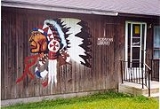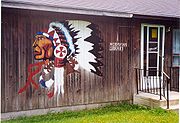
Moravian 47, Ontario
Encyclopedia

Indian reserve
In Canada, an Indian reserve is specified by the Indian Act as a "tract of land, the legal title to which is vested in Her Majesty, that has been set apart by Her Majesty for the use and benefit of a band." The Act also specifies that land reserved for the use and benefit of a band which is not...
located in Chatham-Kent Ontario
Ontario
Ontario is a province of Canada, located in east-central Canada. It is Canada's most populous province and second largest in total area. It is home to the nation's most populous city, Toronto, and the nation's capital, Ottawa....
with an area of 13 km². It is occupied by the Moravian of the Thames First Nation, a part of the Munsee branch of the Lenape
Lenape
The Lenape are an Algonquian group of Native Americans of the Northeastern Woodlands. They are also called Delaware Indians. As a result of the American Revolutionary War and later Indian removals from the eastern United States, today the main groups live in Canada, where they are enrolled in the...
, and is commonly known as Moravian of the Thames reserve. The resident registered population is 457, with another 587 band members living off the reserve.
Following the Gnadenhutten massacre
Gnadenhütten massacre
The Gnadenhutten massacre, also known as the Moravian massacre, was the killing on March 8, 1782, during the American Revolutionary War, of 96 Christian Lenape by colonial American militia from Pennsylvania. The militia attacked Lenape at the Moravian missionary village of Gnadenhütten, Ohio.The...
near present day Gnadenhutten, Ohio
Gnadenhutten, Ohio
Gnadenhutten is a village located on the Tuscarawas River in Tuscarawas County, Ohio, United States and is Ohio's oldest existing settlement. The population was 1,280 at the 2000 census....
, on March 8, 1782, a group of surviving Christian Munsee
Christian Munsee
The Christian Munsee were a group of Lenape native American Indians, primarily Munsee-speaking, who converted to Christianity, following the teachings of the Moravian missionaries...
s left that area led by Moravian missionary David Zeisberger
David Zeisberger
David Zeisberger was a Moravian clergyman and missionary among the Native Americans in the Thirteen Colonies...
, eventually reestablishing their community in what is today southern Ontario
Southern Ontario
Southern Ontario is a region of the province of Ontario, Canada that lies south of the French River and Algonquin Park. Depending on the inclusion of the Parry Sound and Muskoka districts, its surface area would cover between 14 to 15% of the province. It is the southernmost region of...
Canada
Canada
Canada is a North American country consisting of ten provinces and three territories. Located in the northern part of the continent, it extends from the Atlantic Ocean in the east to the Pacific Ocean in the west, and northward into the Arctic Ocean...
. At first temporarily settling near present day Amherstburg, Ontario
Amherstburg, Ontario
Amherstburg is a Canadian town near the mouth of the Detroit River in Essex County, Ontario. It is approximately south of the U.S...
, in 1792, Zeisberger obtained permission from the British colonial authorities for the community to inhabit a site on the Thames River
Thames River (Ontario)
The Thames River is located in southwestern Ontario, Canada.The Thames flows west through southwestern Ontario, through the cities of Woodstock, London and Chatham to Lighthouse Cove on Lake St. Clair...
, near where it is located today. The site of the Battle of the Thames
Battle of the Thames
The Battle of the Thames, also known as the Battle of Moraviantown, was a decisive American victory in the War of 1812. It took place on October 5, 1813, near present-day Chatham, Ontario in Upper Canada...
during the War of 1812
War of 1812
The War of 1812 was a military conflict fought between the forces of the United States of America and those of the British Empire. The Americans declared war in 1812 for several reasons, including trade restrictions because of Britain's ongoing war with France, impressment of American merchant...
, in which the Shawnee
Shawnee
The Shawnee, Shaawanwaki, Shaawanooki and Shaawanowi lenaweeki, are an Algonquian-speaking people native to North America. Historically they inhabited the areas of Ohio, Virginia, West Virginia, Western Maryland, Kentucky, Indiana, and Pennsylvania...
leader Tecumseh
Tecumseh
Tecumseh was a Native American leader of the Shawnee and a large tribal confederacy which opposed the United States during Tecumseh's War and the War of 1812...
was killed by invading American forces, is nearby the community. Following the battle, before leaving the area, the entire community was burned to the ground by American cavalry. It was later rebuilt on the south side of the Thames in its present location. For information about other Munsee reserves see Munsee-Delaware Nation
Munsee-Delaware Nation 1, Ontario
The Munsee-Delaware Nation No. 1 is an Indian reserve on the Thames River, west of St. Thomas, Ontario, Canada, and belongs to the Munsee-Delaware First Nation...
and Six Nations of the Grand River First Nation.
See also
- Christian MunseeChristian MunseeThe Christian Munsee were a group of Lenape native American Indians, primarily Munsee-speaking, who converted to Christianity, following the teachings of the Moravian missionaries...
- Delaware languages
- MunceytownMunsee-Delaware Nation 1, OntarioThe Munsee-Delaware Nation No. 1 is an Indian reserve on the Thames River, west of St. Thomas, Ontario, Canada, and belongs to the Munsee-Delaware First Nation...
- Munsee languageMunsee languageMunsee is an endangered language of the Eastern Algonquian subgroup of the Algonquian language family, itself a branch of the Algic language family. Munsee is one of the two Delaware languages...

